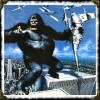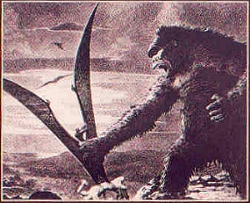|
King
Kong
 King Kong was Max Steiner's
and film music's greatest achievement in the early Thirties.
Starting in 1929, the composer contributed main and end titles to
over fifty RKO-produced pictures prior to Kong. Occasionally,
he was allowed to more fully underscore important pictures such as
Cimarron (1931), and The Most Dangerous Game (1932).
However, it wasn't until 1933 and King Kong that Steiner was offered
a film wherein music would play such an important role in creating
and sustaining atmosphere, characterization and pacing. King Kong was Max Steiner's
and film music's greatest achievement in the early Thirties.
Starting in 1929, the composer contributed main and end titles to
over fifty RKO-produced pictures prior to Kong. Occasionally,
he was allowed to more fully underscore important pictures such as
Cimarron (1931), and The Most Dangerous Game (1932).
However, it wasn't until 1933 and King Kong that Steiner was offered
a film wherein music would play such an important role in creating
and sustaining atmosphere, characterization and pacing.
 According to the composer himself, when Kong was near the
final editing stages, RKO prisident B.B. Kahane told Steiner that he
had doubts about the public's reception to the film, and not to
spend any additional money on music: "Use some old tracks we already
have." Steiner later stated that he didn't have any music tracks for
a picture like this, asking, "What am I going to play, Little
Women?" Merian Cooper stepped in and said, "Maxie, go ahead and
score the picture to the best of your ability and don't worry about
the cost because I will pay for the orchestra and any extra
charges." Steiner did, adding $50,000 to the budget.
According to the composer himself, when Kong was near the
final editing stages, RKO prisident B.B. Kahane told Steiner that he
had doubts about the public's reception to the film, and not to
spend any additional money on music: "Use some old tracks we already
have." Steiner later stated that he didn't have any music tracks for
a picture like this, asking, "What am I going to play, Little
Women?" Merian Cooper stepped in and said, "Maxie, go ahead and
score the picture to the best of your ability and don't worry about
the cost because I will pay for the orchestra and any extra
charges." Steiner did, adding $50,000 to the budget.
 The composer worked in close collaboration with
the director during the composing of the score. During the early
stages, Steiner suggested that it might be effective not to
underscore the first part of the film which dealt with the realities
of depression-torn New York and the subsequent voyage to Kong's
island. Merian Cooper agreed. Music would be brought in when reality
gives way to dream-like fantasy as the ship moves through the fog
surrounding Skull Island. From that point on, music is present
throughout most of the film. The composer worked in close collaboration with
the director during the composing of the score. During the early
stages, Steiner suggested that it might be effective not to
underscore the first part of the film which dealt with the realities
of depression-torn New York and the subsequent voyage to Kong's
island. Merian Cooper agreed. Music would be brought in when reality
gives way to dream-like fantasy as the ship moves through the fog
surrounding Skull Island. From that point on, music is present
throughout most of the film.
 The score was begun by Steiner on December 9,
1932, and completed about eight weeks later. As was his usual
custom, the composer conducted the recording himself, using an
orchestra of as many as 46 players, a number considerably highter
than was customary in the film studios of the day. After the score
was recorded, Murray Spivak, the sound effects technician,
altered the pitches and placement of the sound effects to conform to
the music--an innovation at the time. This, he felt, would make
bearable the almost uninterrupted cacophony of sound effects and
thunderous music heard during the last two-thirds of the picture. The score was begun by Steiner on December 9,
1932, and completed about eight weeks later. As was his usual
custom, the composer conducted the recording himself, using an
orchestra of as many as 46 players, a number considerably highter
than was customary in the film studios of the day. After the score
was recorded, Murray Spivak, the sound effects technician,
altered the pitches and placement of the sound effects to conform to
the music--an innovation at the time. This, he felt, would make
bearable the almost uninterrupted cacophony of sound effects and
thunderous music heard during the last two-thirds of the picture.
 With over 300 scores to his credit, King Kong remained one of
the composer's personal favorites. Steiner called it one of his few
modernistic scores, and added that while it "worried" some of his
friends in Vienna and America, it won him new admirers in France and
Russia. Kong's music proved extremely durable. The music
tracks were used in many subsequent RKO productions: Son of Kong,
The Last of the Mohicans, and dozens of others. Steiner
himself reprised certain portions of the score in Warner's White
Heat, Distant Drums, and So Big.
With over 300 scores to his credit, King Kong remained one of
the composer's personal favorites. Steiner called it one of his few
modernistic scores, and added that while it "worried" some of his
friends in Vienna and America, it won him new admirers in France and
Russia. Kong's music proved extremely durable. The music
tracks were used in many subsequent RKO productions: Son of Kong,
The Last of the Mohicans, and dozens of others. Steiner
himself reprised certain portions of the score in Warner's White
Heat, Distant Drums, and So Big.
Few film scores generate the admiration and
affection that King Kong does for film buffs and students
everywhere. Created when sound film was in its infancy, the power,
originality, and importance of this score can not be overestimated.
It is one of the key works of our cinematic heritage, one which
furnished a sturdy foundation for the style and artistic principles
of Hollywood's film music for many years to come.
|
|
|
![]()